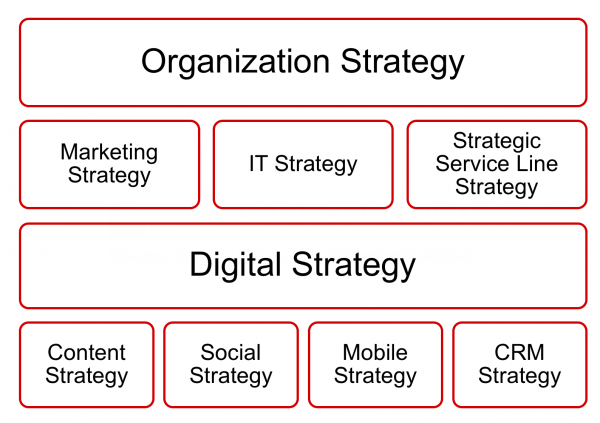There are quite a few fallacious assumptions made in the construction of digital strategy. One of the most common ones I witness is confusion between strategy and roadmap. When I take the necessary time to review an organization’s existing digital strategy documentation, more often than not I am presented with a document that outlines an assessment of where an organization is versus where they want to be. What they fail to understand is that strategy is not a map from the here to the then. Instead, a strategy is about composing the patterns of decision making necessary to occupy the precise positioning within a complex market that will set an organization up for the most success for their specific engagement drivers.
Another common veil of mystery that becomes uncovered for our clients is when they understand the strategic hierarchy within which a digital strategy must be placed. A digital strategy created in a vacuum is a digital strategy that will sit on a shelf looking pretty and not much else. If you want a digital strategy that does more than look pretty and not say much then it needs to take and give the appropriate calls within the strategic hierarchy.
Introducing the Strategic Hierarchy
At the very top of the hierarchy you have the overriding organization strategy. This is the parent to all other strategies, and if it either doesn’t exist or is not appropriately communicated across the organization, then the strategic problems of that organization will be fundamental to their challenges. I worked with one organization that definitely had an organizational strategy but the only individuals that knew about it were the C-level and the board members. How can a strategy be implemented if it is not successfully communicated to those that can put these plans in motion?
On the next level of this strategic hierarchy you have the Marketing Strategy, the IT Strategy, and the strategies for strategic business units or service lines. These strategies are important. They take their call from organizational strategy, but they have some important things to say as well. The Marketing Strategy will translate the organizational strategy into its particular set of core competencies. The same is true for technology and other parts of the business.
Now we get to the digital strategy. As you can see, it lives within an ecosystem, and becomes the umbrella strategy for how an organization will position all of those technologies that are used to connect people to people or people to knowledge. These are the human and behavior centric technology decisions and, rightfully so, they need to be informed by the parent strategies. However, this strategy then becomes the parent to such strategies as the social media strategy, the content strategy (in terms of web content management), the mobile strategy, and the loyalty strategy (typically dominated by CRM these days but will evolve into more sophisticated Member 360/Patient 360 ecosystems over the next few years).
Getting Strategy Right
Quite frankly, when I see activities like social media fail within an organization it is oftentimes because social media becomes “the cute thing marketing does” instead of being completely plugged in to the unique solutions it can provide to the drivers that matter to the entire organization. A social media strategy that is connected to the organization evolves away from being a press release conduit and towards a medium for population health education and converting unknown consumers into patients. It can only do so when it is properly seated within the strategic hierarchy.


